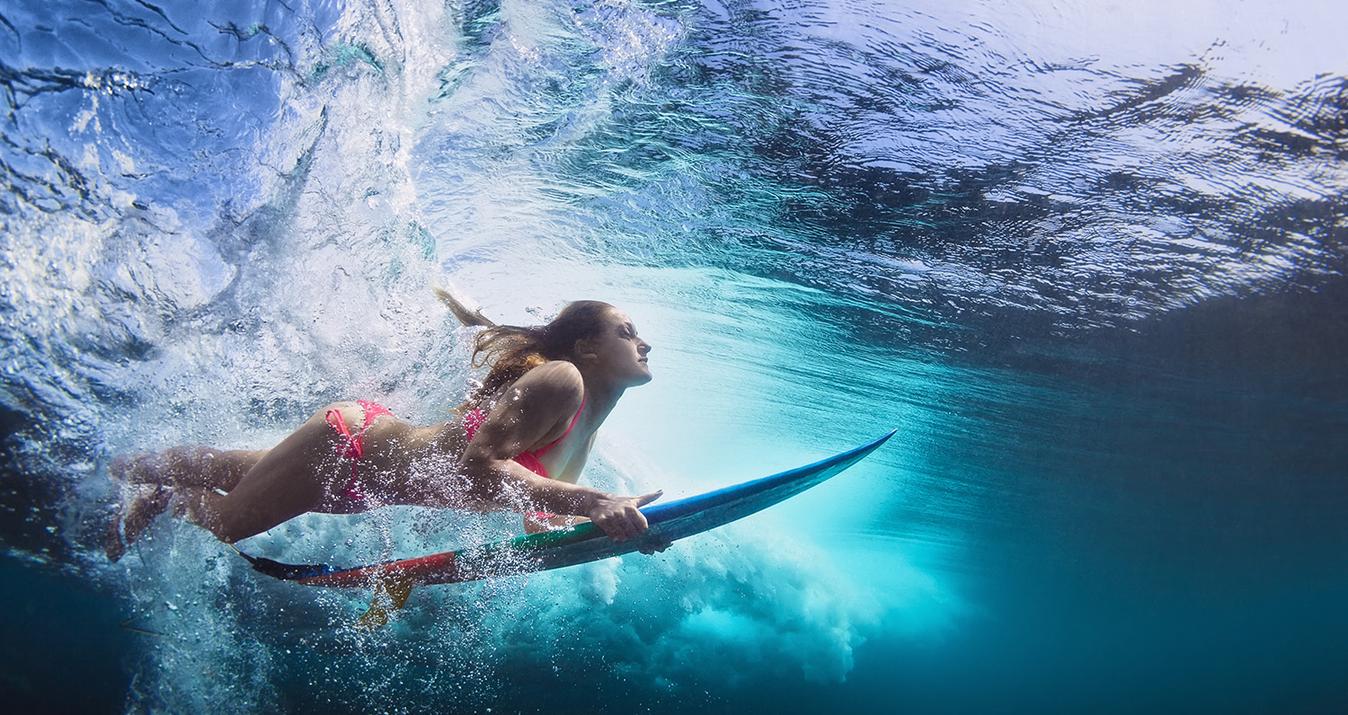Sometimes you want to capture interesting moments at sporting events or just during a workout. Anyone who has ever tried to photograph sports knows that it is not an easy task. However, there are a few secrets that can make such a task easier. In this article, we will give you some simple sports photography tips to help you take good pictures, even if you're a beginner.
Sports photography is a hobby or a profession for the most die-hard fans. It is an art that requires skillfully capturing the movement, dynamics, and outstanding moments of various sporting events, whether it is football, hockey, rugby, or tennis. However, it is far from an effortless task. If you've ever watched photographers on the sidelines of a soccer game, you can't help but be impressed by their gear with massive lenses and constant vigilance to capture every nuanced movement on the field.
But before you head out to professional sports, you need to learn, and the best way to do that is through small matches and events where you can practice. We've selected only the best tips for sports photography to help you take better shots and break into a new genre. Also, maybe someone will turn out to be interested enough to make a career out of it.
By the way, such photo sessions often result in a large number of images, especially when capturing fast-paced action. Photo organizing software like Luminar Neo helps you efficiently sort and categorize all your footage based on various criteria, such as an event, date, team, or player.
What Does Sports Photography Mean?
This is a specialized genre of photography that focuses on capturing dynamic and action-packed moments in various sporting events. It involves capturing athletes in motion to showcase their skills, emotions, and the overall intensity of the sporting activity. Photographers strive to capture key moments such as a goal, a sprint, a jump, or a pivotal play, often requiring precise timing and anticipation.
This genre typically takes place during live sporting events, ranging from professional leagues and tournaments to amateur and school competitions. It covers a wide range of activities, including but not limited to football, basketball, baseball, tennis, golf, track and field, swimming, gymnastics, and motorsports. It also includes sports-related events such as training sessions, press conferences, and behind-the-scenes moments.
 To shoot sports, you need to know your camera and have a good understanding of the activity you are capturing, as well as excellent technical skills. You must also work quickly, adapt to changing conditions, and take compelling images that tell a story or convey the intensity and passion of the game. Sports photography requires you to be fully engaged and immersed in the game.
To shoot sports, you need to know your camera and have a good understanding of the activity you are capturing, as well as excellent technical skills. You must also work quickly, adapt to changing conditions, and take compelling images that tell a story or convey the intensity and passion of the game. Sports photography requires you to be fully engaged and immersed in the game.
In addition, professional photographers often work for media outlets or sporting organizations, providing images for editorial purposes, news coverage, advertising campaigns, publications, and athlete portfolios. This is essential to documenting sports history, celebrating athletic achievements, and evoking the excitement and energy associated with sports.
By the way, online photo storage makes sharing your best shots effortless. You can easily create links or share albums with teammates, coaches, friends, or clients so they can view or download the images.
What Gear Do I Need When Taking Sports Photos?
This is one of the few fields of photography where the quality and specification of the gear are fundamental. You can't capture movement and show dynamics beautifully with the first camera you see, let alone a smartphone. So, let's take a look at the essential gear typically used in this genre:
- Use a DSLR or mirrorless device with manual controls for optimal control over settings and image quality. These cameras offer fast autofocus and burst mode capabilities that are critical for sports photography.
- A telephoto lens is essential for capturing distant subjects. Look for options in the 70-200mm or 100-400mm range, depending on the sport and your position. Longer lenses, such as 300mm or 400mm, are ideal for capturing action from further away.
- Depending on the sport and shooting conditions, a wide-aperture prime lens may be useful. Such optics allow for fast shutter speeds, better low-light performance, and a shallow depth of field to isolate the subject from the background.
- While not always necessary, using a monopod or tripod when taking sports pictures provides stability and support, especially when using heavy telephoto optics for long periods. This helps reduce camera shake and allows for smoother panning.
- Although natural light is preferred, there may be situations, such as indoor sports or low-light conditions, where an external flash can help provide additional illumination and freeze the action.
 And remember, you can't skip the post-processing stage anyway. Luminar Neo AI photo editor can streamline the process of enhancing and managing your sports shots. It offers a range of intelligent features and tools to help you achieve professional results.
And remember, you can't skip the post-processing stage anyway. Luminar Neo AI photo editor can streamline the process of enhancing and managing your sports shots. It offers a range of intelligent features and tools to help you achieve professional results.
Advanced yet easy-to-use photo editor
Get Luminar Neo NowThe Best Sports Photography Tips and Techniques
Sports photography can be both challenging and incredibly rewarding. Capturing the action, emotion, and intensity of athletes in motion requires a combination of technical skill and artistic vision. So, take a look at some expert sport photography tips to help you elevate your skills.
Know the Sport
 Understanding the rules, key moments, and player positions of the event you're photographing gives you a competitive edge. You can anticipate the action and position yourself for the best shots.
Understanding the rules, key moments, and player positions of the event you're photographing gives you a competitive edge. You can anticipate the action and position yourself for the best shots.
Choose the Right Lens
 Sports often require capturing distant subjects, so a telephoto optic is essential. A zoom lens in the 70-200mm or 100-400mm focal length range is versatile and suitable for a variety of sports. For indoor activities, you may need a lower aperture to compensate for lower light levels.
Sports often require capturing distant subjects, so a telephoto optic is essential. A zoom lens in the 70-200mm or 100-400mm focal length range is versatile and suitable for a variety of sports. For indoor activities, you may need a lower aperture to compensate for lower light levels.
Using Burst Mode
 So, how to take sports photos? All sporting activities are full of fast-paced action, and capturing the decisive moment is crucial. Set your camera to burst or continuous shooting mode to take a series of pictures in quick succession. This increases your chances of getting the perfect shot.
So, how to take sports photos? All sporting activities are full of fast-paced action, and capturing the decisive moment is crucial. Set your camera to burst or continuous shooting mode to take a series of pictures in quick succession. This increases your chances of getting the perfect shot.
Master Your Camera Settings
 Understand all settings and learn how to adjust them quickly. For example, you can faster your shutter speed to capture athletes in their peak moments. To freeze the intense action with your camera, use a fast shutter speed (1/1000s or faster) and continuous autofocus to catch every exhilarating moment.
Understand all settings and learn how to adjust them quickly. For example, you can faster your shutter speed to capture athletes in their peak moments. To freeze the intense action with your camera, use a fast shutter speed (1/1000s or faster) and continuous autofocus to catch every exhilarating moment.
Pre-focusing and Continuous Autofocus
 To ensure sharp focus, pre-focus on a spot where the action is likely to be. Also, use continuous autofocus to track moving subjects and maintain focus as they move across the frame. There is another great option. For example, you can use a free Photoshop action to emphasize motion, add dynamic effects, or increase the intensity and drama of the activity in your shots.
To ensure sharp focus, pre-focus on a spot where the action is likely to be. Also, use continuous autofocus to track moving subjects and maintain focus as they move across the frame. There is another great option. For example, you can use a free Photoshop action to emphasize motion, add dynamic effects, or increase the intensity and drama of the activity in your shots.
Take Pictures in RAW Format
 Capturing images in RAW gives you more flexibility in post-processing with the Luminar Neo photo editor. Such files retain more info, giving you more control over exposure, color, and sharpness in editing. By the way, you can always find the best free Mac photo editor in our blog.
Capturing images in RAW gives you more flexibility in post-processing with the Luminar Neo photo editor. Such files retain more info, giving you more control over exposure, color, and sharpness in editing. By the way, you can always find the best free Mac photo editor in our blog.
Sports Photography Ideas for the Most Stunning Shots
Of course, even with all the specifics of this genre, you still need to do your best to stand out from other photographers. Here are some great ideas you can try right now:
- Capture the emotion. Sports photography isn't just about action; it's also about capturing the emotion and intensity of the athletes. Look for moments of celebration, determination, and interaction between players to tell a more compelling story through your photos.
- Experiment with angles and composition. Vary your photography angles to add visual interest and capture unique perspectives. Try low spots, behind the goal, or from the sidelines to create dynamic images. Pay attention to the background and use it to enhance the composition.
- Details and close-ups. Zoom in on the subtle elements of a sport to capture unique and visually interesting shots. Focus on the texture of a basketball player's hands, the dirt on a baseball player's glove, or the splashes in a swimmer's wake. These close-ups can tell a story and reveal the subtle details that often go unnoticed.
- Silhouettes and Backlighting. Use backlighting to create dramatic backlights of athletes against the sky or stadium lights. This technique can add a sense of mystery and create stunning and visually compelling images. Find opportunities where the subject is backlit and experiment with different exposure settings to achieve the desired effect.
- Pan and motion blur. To create a sense of speed and dynamism, try panning with the athletes as they move. Use a slower shutter speed and follow the subject's movement, keeping them in focus while blurring the backdrop. This style adds a sense of movement and energy to your shots, emphasizing the speed and intensity of the sport.
- Anticipate and follow the action. Anticipation is the key to sports photography. Watch the game closely and anticipate the key moments of action. Follow the athletes' movements with your camera to capture the most compelling shots.
- Environmental portraits. Photograph athletes in their training facility, locker room, or in the environment that defines their sport. These portraits can offer a glimpse into their world and provide context for their dedication and passion for the sport.
 This type of photography requires practice and patience. It takes time to develop the skills to capture the perfect moment. Keep practicing, learn from your successes and failures, and continually refine your techniques.
This type of photography requires practice and patience. It takes time to develop the skills to capture the perfect moment. Keep practicing, learn from your successes and failures, and continually refine your techniques.
Conclusion
Well, this genre of photography is exciting but challenging. It can be frustrating at times, but it's always worth it in the end. If you need inspiration or get stuck, look to other photographers or the Internet for advice. Most importantly, have fun and capture moments that are meaningful to you. And remember, you can always use Luminar Neo online photo editor to make your best shots simply unbeatable!
FAQ
What Are Some Essential Tips for Sports Photography?
When photographing athletes, you need to know the sport, anticipate the action, use burst mode, capture emotion, and experiment with angles. Also, try to focus on details and tell a story with your shots. Patience is the key to capturing the perfect moment.
How Can I Improve My Sport Photography Skills and Capture Dynamic Action?
Consider studying the sport and understanding its key moments, using fast shutter speeds to freeze motion, and tracking the action with autofocus. Remember to practice regularly to develop your timing and anticipation skills.
Are There Any Creative Ideas or Techniques for Taking Impressive Sports Photos?
While action photos are important, candid moments off the field or during breaks can also be compelling. These behind-the-scenes shots can show the human side of sports and provide a different perspective. You can also experiment with post-processing tools in Luminar Neo to enhance your images. Adjust contrast and saturation, or use black-and-white conversions to create a dramatic or timeless look.













